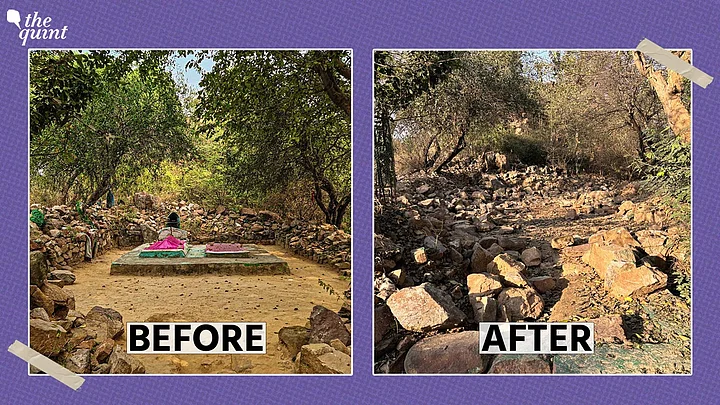The 12th-century shrine of Baba Haji Rozbih – believed to be one of the oldest Sufi saints in New Delhi – once stood near the Qila Lal Kot, deep inside Sanjay Van, a reserved forest area in Mehrauli.
Not anymore.
The approximately 1,000-year-old Sufi shrine is among the several religious structures that were razed to the ground by the Delhi Development Authority (DDA) – responsible for developing commercial land in Delhi – on 30 January, as part of a drive to remove "illegal encroachments" inside the 780-acre Sanjay Van area.
"The grave of Baba Haji Rozbih has been here for over 1,000 years. The DDA, on the other hand, has existed only for about a 100 years or so. How can something from the past be an encroachment in the present?" asked Delhi-based historian and writer Rana Safvi, in a conversation with The Quint.
The news of the demolition surfaced on social media on Sunday, 4 February, when Sair e Hind, an Instagram page on Delhi's history, posted a photo of the debris where the grave of Baba Haji Rozbih once stood.
The Quint visited the spot on Tuesday, 6 February, and found nothing but rubble near the site of the shrine.
Who Was Baba Haji Rozbih?
According to Delhi-based historian and author Rana Safvi, Haji Rozbih was one of the earliest Sufi saints to enter Delhi during the reign of Rai Pithaura (or Rajput king Prithviraj Chauhan).
"The tomb of Haji Rozbih is near the Fateh Burj of the Qila Rai Pithaura. It is a simple, open air, whitewashed, and plastered grave. It is believed that Haji Rozbih lived in a cave near the ditch of the fort and his teachings and persuasive gentleness attracted many disciples," Safvi told The Quint.
While not much is known about the exact year when Haji Rozbih came to Delhi, according to Safvi, the shrine of the saint "was revered by Hindus and Muslims alike in that area for generations now."
ASI Records Structure in 1922; DDA Calls It 'Illegal Encroachment'
In a statement, the DDA said that several religious structures inside Sanjay Van, which is part of the Southern Ridge, were demolished.
It said it acted on the recommendation of a panel set up to assess the encroachment. This panel, set up under the chairmanship of the district magistrate, South Delhi, suggested removing the said "illegal structures."
"Sanjay Van is a reserved forest spread over an area of 780 acre, which is part of the Southern Ridge. As per the Ridge Management Board, the ridge area should be free from all types of illegal encroachment."DDA statement
Over 5,000 square metres (sqm) of land had been reclaimed in the exercise, the DDA added.
DDA officials confirmed to Hindustan Times that the shrine was one of the structures demolished.
However, the shrine, which was at the entrance of Qila Lal Kot, finds mention in page 86 of the 'List of Muhammadan and Hindu Monuments, Volume III' published by Maulvi Zafar Hasan, Assistant Superintendent, Archaeological Survey of India (ASI) in 1922.
According to the list, as seen by The Quint, "Baba Haji Rozbih is revered as one of the oldest saints of Delhi. He is said to have come during the time of Rai Pithaura and took up his abode in a cave near the ditch of the fort."
It has existed since the "latter part of the 12th century A.D.," the list states.
The other structures that were demolished include the Akhundji Mosque, the adjacent Madrasa Bahrul Uloom, and a decades-old graveyard.
'How Is a 1,000-Year-Old Shrine an Encroachment?' Ask Historians
According to Rana Safvi, calling the religious structures inside Sanjay Van "encroachments" was "incorrect."
Historians also pointed out that the Sanjay Van was notified as a reserved forest area only in 1994. So, how could the old mosque have been an encroachment, they asked.
The DDA's document on Sanjay Van, which has been accessed by The Quint, states that it is "a part of Mehrauli/South central ridge of Delhi..."
"The Mehrauli ridge has been under tremendous pressure due to ever increasing urbanisation and development. To protect and develop this heritage into a green belt , DDA in 70s carved this area of 784 acres now called Sanjay Van... One can approach Sanjay Van ( a notified reserve forest as per the the 1994 notification under section 4 of the Indian Forest Act( 1927 ) from Aruna Asaf Ali marg or from Qutub Institutional area... [sic]"DDA on Sanjay Van
Sam Dalrymple, a historian and writer, called the demolition of the shrine a "massive loss" for Delhi's heritage.
"Sanjay Van is filled with the earliest heritage in all of Delhi. Many of the graves that have been demolished are of the Ghurid soldiers who conquered the city. The shrines there are some if the oldest in the subcontinent!" Dalrymple told The Quint.
For 30-year-old Ishtiyaque Ahmad, a resident of Okhla's Jamia Nagar, the 12th century shrine, which he used to visit every weekend, was a place of "bliss."
"I used to visit the shrine every weekend. The place was bliss for me as I found peace sitting there away from the hustle-bustle culture and busy life back in Delhi. It was demolished without any notice, which is very sad..."Ahmad told The Quint
Despite multiple attempts, The Quint was unable to reach DDA's Public Relations Officer via calls or messages. This story will be updated if and when we receive a response.
